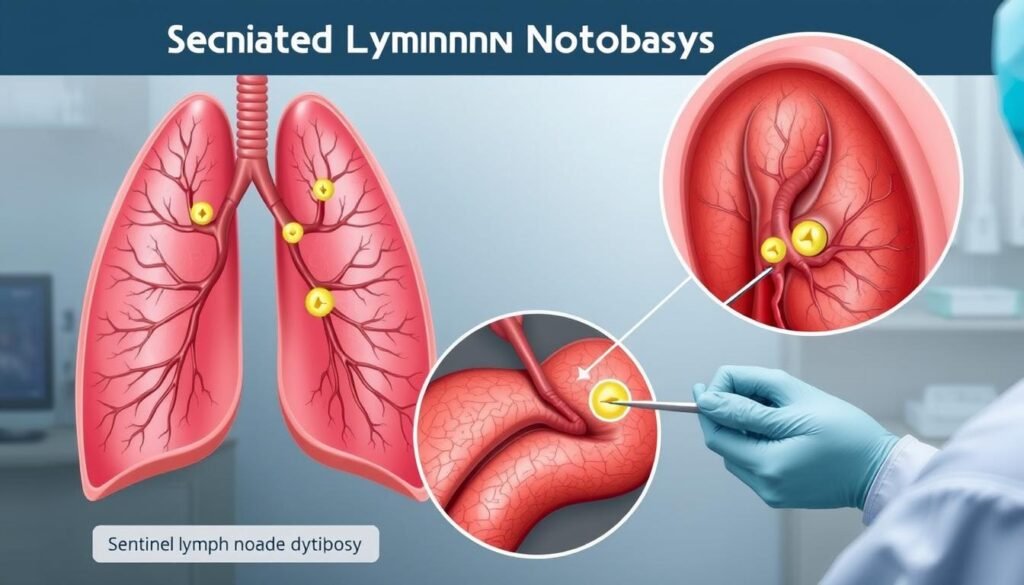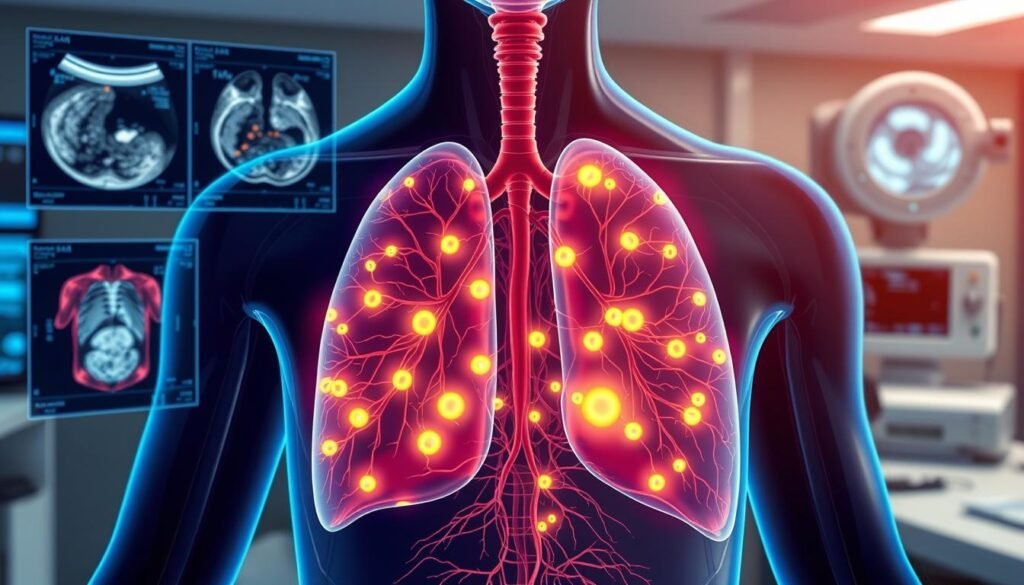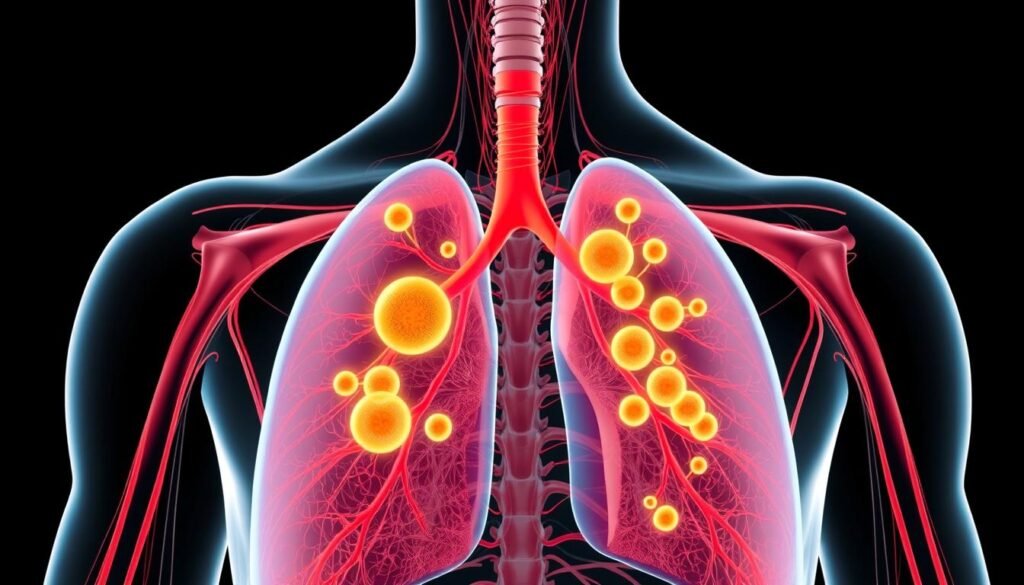Lung cancer leads in cancer-related deaths, making up about 25% of all cancer deaths. Most lung cancer cases are non-small cell lung cancer (NSCLC), which is around 85%. Lymph nodes play a crucial role in how lung cancer spreads. They are the main path for cancer cells to move. Knowing about the lymphatic system helps us see how cancer grows and spreads using lymph vessels. Lymph nodes are often the spots where this movement happens. This knowledge is vital for NSCLC’s diagnosis and treatment.
Key Takeaways
- Lung cancer is the most lethal cancer type, emphasizing the need for effective treatment strategies.
- Non-small cell lung cancer (NSCLC) represents the majority of lung cancer cases.
- Lymph node metastasis is a critical pathway for the spread of NSCLC.
- Occult micrometastatic cancer cells can exist in lymph nodes before diagnosis.
- Understanding lymphangiogenesis is crucial for diagnosing and managing lung cancer.
- Recent treatments, including immunotherapy, show promise for advanced NSCLC patients.
Understanding the Lymphatic System
The lymphatic system is a crucial network in our body. It helps with health and the immune response. It includes tubes, tissues, and nodes that move lymph around. This fluid has immune cells. Studies have shown how it works and its role in diseases like cancer.
What is the Lymphatic System?
The lymphatic system works alongside the circulatory system. It moves lymphatic fluid, helping our immunity. The fluid carries lymphocytes, important for fighting off diseases. Vessels have valves that ensure lymph flows in one direction. This brings immune substances where needed.
Functions of Lymph Nodes in the Body
Lymph nodes are vital for filtering in the lymphatic system. They catch harmful substances, including cancer cells. These nodes are found under arms, in the groin, neck, and abdomen. They’re key for a strong immune system.
- Immune Surveillance: Lymph nodes check lymph for dangers, starting defense responses.
- Fluid Balance: They control the body’s fluid levels, preventing issues like swelling.
- Memory Cell Storage: Nodes keep memory T cells for long-lasting immunity.
A well-connected lymphatic system is crucial for our health. Healthy nodes and vessels play a big part in this.
The Role of Lymph Nodes in Lung Cancer Spread
Lung cancer’s growth is closely linked to lymph nodes. These nodes play a key role in the cancer spread process. It’s important to know how cancer cells move through lymph pathways. This helps in understanding lung cancer better. When cancer cells break away from the main tumor, they travel through these pathways to nearby nodes. This movement is key for planning the treatment and staging the cancer.
How Cancer Cells Spread Through Lymph Pathways
After leaving the main lung tumor, cancer cells can move into the lymph system. They tend to gather first in nearby lymph nodes. This includes nodes inside the lung and around the chest area. Moving through these nodes often means the cancer will spread more. Lymph nodes work as filters. Spotting cancer cells in them helps doctors decide on the best treatment. Tools like CT scans and biopsies are crucial for seeing if lymph nodes are affected, showing how far the cancer spread is.
Importance of Lymph Node Locations
Where lymph nodes are located can greatly affect the cancer outcome. Nodes on the same side as the tumor spread differently than nodes on the opposite side.
Knowing which nodes are affected helps doctors pick the right treatment. The TNM system is used to stage lung cancer. It looks closely at lymph nodes to figure out the cancer’s stage and how to treat it. More about this system can be found here, showing how it affects cancer care.
How Lung Cancer Metastasis Occurs
Lung cancer metastasis is when cancer cells move from the lungs to other body parts. It marks a serious stage of the disease. Patients and doctors face challenges like grasping the lung cancer metastasis stages and pinpointing the metastatic spread factors.
Stages of Lung Cancer and Metastasis
The TNM system classifies lung cancer. It looks at Tumor size, Node involvement, and Metastatic spread. This helps doctors and patients understand the cancer’s stage. Stages go from 0 to 4.
- Stage 0: No lymph node involvement.
- Stage 1: Cancer is only in the lung.
- Stage 2: May have reached nearby lymph nodes.
- Stages 3A, 3B, or 3C: Cancer is advanced and has spread to nearby tissues and nodes.
- Stage 4: Cancer has spread to far parts like the brain, bones, or liver.
Factors Influencing Metastatic Spread
Many factors influence lung cancer’s spread. Tumor characteristics and location are crucial. Initially, treatment aims to control the cancer and help the patient live better.
Metastasis often hits these organs:
- Brain
- Bones
- Liver
- Adrenal glands
- Other lung areas
Understanding these aspects demonstrates early detection and treatment’s value. For more info, check resources like studies on lung cancer metastasis processes. They offer in-depth knowledge for those dealing with this illness.
Sentinel Lymph Node Biopsy in Lung Cancer
A sentinel lymph node biopsy is key for checking if lung cancer has spread. It finds the first lymph nodes, or sentinel nodes, that cancer cells go to from the tumor. Knowing how a sentinel lymph node biopsy works is critical for diagnosing and planning lung cancer treatment.
What is a Sentinel Lymph Node Biopsy?
This procedure uses a dye or radioactive substance injected near the tumor. This makes the sentinel nodes visible, which are the first to get lymph fluid from the tumor. By examining these nodes, doctors can tell if the cancer has spread. Identifying and checking sentinel nodes helps decide the lung cancer stage and treatment plan.
Significance of Sentinel Nodes in Lung Cancer
Sentinel nodes play a big role in treating lung cancer. Their condition greatly affects how doctors decide on treatment. If these nodes are cancerous, it might mean the cancer has spread more. This would require more treatments or surgeries. But, if these nodes don’t have cancer, treatments might be less intense. New technologies like fluorescence imaging are improving how doctors use this biopsy in lung cancer care.

Lymph Node Involvement and Lung Cancer Staging
The TNM staging system is key for understanding lung cancer. It looks at tumor size, regional lymph node involvement, and if the cancer has spread. This system sorts lung cancer into stages. For non-small cell lung cancer (NSCLC), stages range from I to IV. Stage IV means the cancer has spread far. Small cell lung cancer (SCLC) is split into limited and extensive stages, depending on spread.
TNM Staging System Explained
Lymph node status is vital in the TNM system. It helps guide treatment choices, especially in NSCLC. If N2 nodes are involved, the outlook isn’t as good. Techniques like endobronchial ultrasound (EBUS) and mediastinoscopy let doctors check lymph nodes accurately. Knowing exactly which nodes are affected is key to customizing treatment.
How Lymph Nodes Affect Prognosis
Lymph node involvement greatly affects survival chances after a lung cancer diagnosis. People with cancer in one N2 zone have better survival rates than those with many N2 zones affected. This difference is clear in five-year survival statistics. Knowing about lymph node involvement helps doctors predict outcomes and plan treatment. More information on lung cancer stages is available here.
| Stage | Lymph Node Involvement | Five-Year Survival Rate |
|---|---|---|
| I | No lymph node involvement | Approximately 70-92% |
| II | Regional lymph nodes involved | Approximately 50% |
| III | Multiple lymph nodes involved | Approximately 25-40% |
| IV | Metastasis to distant lymph nodes or organs | Less than 5% |
Lymph Node Mapping Techniques
Lymph node mapping is key in guiding cancer treatment, especially for lung cancer. It uses advanced imaging and tracer substances to highlight lymph paths and identify potential cancer-harboring nodes. This provides a clear view of lymph involvement, improving surgery results and patient care.
What is Lymph Node Mapping?
This process uses imaging and tracer injections to find key lymph nodes, known as sentinel lymph nodes (SLNs). It’s crucial for spotting how non-small cell lung cancer spreads. This helps doctors make better surgery choices.
Advantages of Mapping for Cancer Treatment
Using lymph node mapping boosts lung cancer treatment in several ways:
- Enhanced Surgical Precision: It leads to precise removal of cancer while keeping healthy nodes intact.
- Improved Clinical Outcomes: Knowing the status of lymph nodes means more successful tumor removals. This improves chances of survival.
- Targeted Treatment Approaches: The technique helps customize therapy based on the risk of spread. Thus, making treatment more tailored.
- Minimized Complications: It lowers the risk of taking out unneeded lymph nodes. This helps avoid complications after surgery.

Recent studies show a high detection rate of sentinel nodes in lung cancer patients, proving lymph mapping’s value. With a 95.2% success rate in finding these crucial nodes, it’s making cancer treatments more effective.
Impact of Tumor Draining Lymph Nodes
Lymph nodes near tumors are key in lung cancer progress. They show how cancer spreads and affects our body’s defense. By learning about these nodes, doctors can find better treatments and predict how well a patient might do.
Understanding Tumor Draining Mechanisms
Lymph nodes filter fluid that might carry cancer cells. This shows how crucial they are in fighting cancer and avoiding detection by the immune system. They work by:
- Activating responses that carry cancer cells through the body faster, due to certain growth factors.
- Helping grow special immune cells that attack cancer, which is vital for beating the disease.
- Changing to make it easier for cancer to spread, by making more space and pathways for cancer cells.
Role of Adjacent Lymph Nodes
Nodes close to the tumor are often the first to be affected when cancer spreads. Their location makes them key to how the disease moves. Here’s why:
- For lung cancer surgeries, about 45% of patients see the cancer return, depending a lot on these nodes.
- If all the lymph nodes are removed, patients live about 49 days on average, but over 88 days if not.
- Removing these nodes sometimes helps patients live longer, but it depends on the type of cancer.
Ongoing studies on these nodes and cancer are vital. They help doctors plan better treatments. They’re looking into how these findings can improve immune-based therapies and surgery choices.
| Factor | Impact on Survival |
|---|---|
| Complete dLN resection | 49 days |
| Intact lymph nodes | >88 days |
| Post-operative recurrence rate | 45% |
Lymph Node Staging and Its Importance
Lymph node staging is key in evaluating lung cancer extent. It greatly affects treatment results. Knowing the stage accurately can change prognosis and treatment choices, making it critical for the best care.
Role in Predicting Treatment Outcomes
The TNM system, especially the N category, is crucial for lymph node status. Staging ranges from N0 to N3, showing how far cancer has spread to lymph nodes. For example, N0 means no spread, leading to better outcomes. Meanwhile, later stages might need harsh treatments, including chemo and radiation.
Different Stages Related to Lymph Node Involvement
Lung cancer stages differ based on lymph node status. Here’s a simple guide using the TNM system:
| Stage | Lymph Node Involvement | Treatment Implications |
|---|---|---|
| Stage 0 | N0: No lymph node involvement | Surgery or observation |
| Stage I | N1: Lymph nodes near the tumor | Surgery and maybe extra therapy |
| Stage II | N2: Lymph nodes in the mediastinum | Surgery, chemo, and radiation mix |
| Stage III | N3: More lymph node involvement | Intense treatment, often multiple methods |
Oncologists use lymph node staging to create customized treatment plans. To learn how staging influences lung cancer care, check this resource.

Lymphadenectomy for Lung Cancer Treatment
Lymphadenectomy is key in cancer therapy. It removes lymph nodes to check for cancer. This is vital for choosing lung cancer treatments.
What is Lymphadenectomy?
This surgery helps stage lung cancer and plan treatment. It checks if lymph nodes are affected. This knowledge guides patient care options.
When is Lymphadenectomy Recommended?
It’s advised when lymph node involvement seems likely. It benefits those with widespread disease. This surgery improves chances in complex cases.
By doing this, doctors can customize treatments for better outcomes. Lymphadenectomy plays a crucial role in lung cancer care, showing the value of precise surgeries.
Conclusion
Lymph nodes play a crucial part in battling lung cancer. They are key to how the cancer spreads. Knowing about lymph nodes in lung cancer helps doctors decide on treatment and predicts chances of recovery. It is critical to understand how cancer affects lymph nodes, including how to find and treat it.
Recent research shows that even small lung cancers can be managed with less invasive treatments. The British Thoracic Society says removing at least six lymph node stations during surgery is best. This helps doctors better understand the patient’s condition and what the future might hold.
New studies into how cancer spreads through lymph nodes are paving the way for better treatments. Tools like robotic surgery are making a difference. As we learn more, treatments will improve, helping people live longer and better lives after a lung cancer diagnosis.